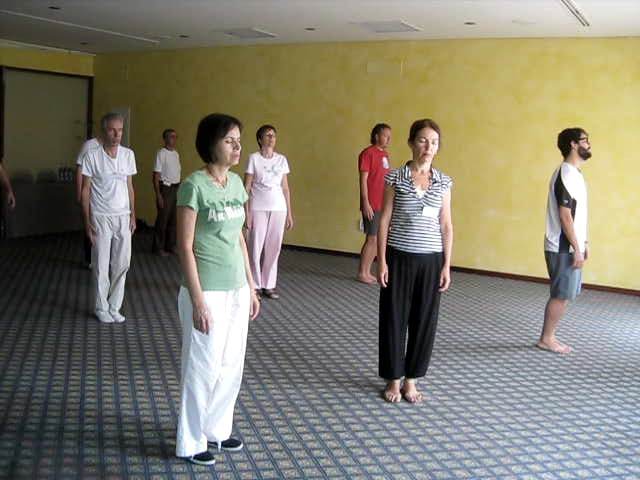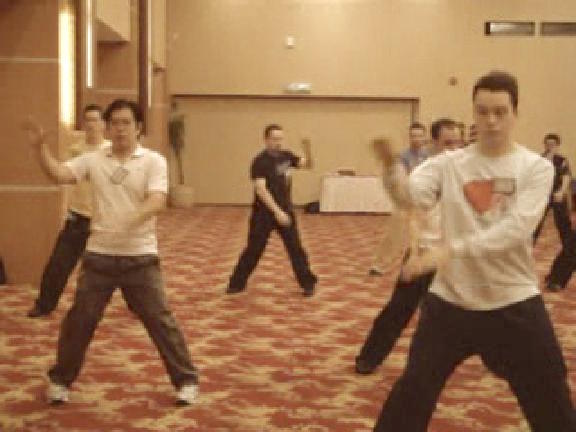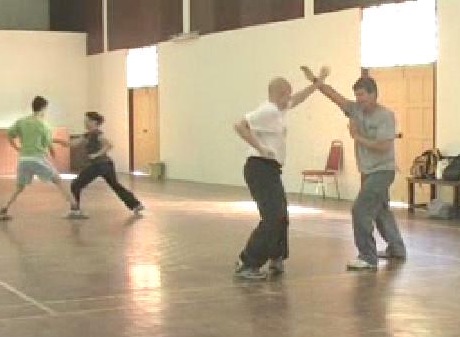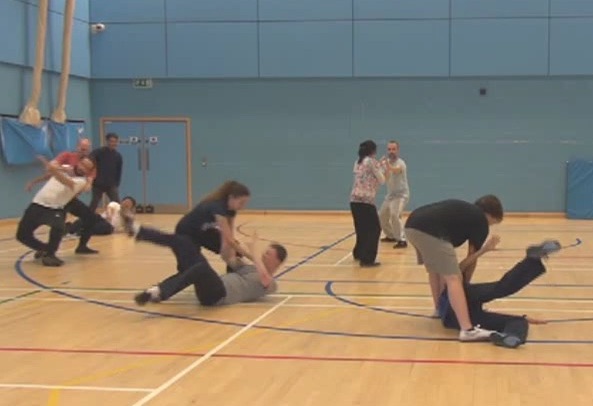SELECTION OF QUESTIONS AND ANSWERS
OCTOBER 2018 PART 3

Why practice sitting meditation when you can have the same results faster and safer by practicing standing meditation?
Question 1
My mind wanders and I do sitting meditation to tame it. But I feel congestion in my chest after the sitting meditation. What should I practice?
— Franz, Austria
Answer
Before I answer your question, I shall say something very important about meditation.
Many students have asked me to teach sitting meditation. I decline because of a very significant reason. By practicing standing meditation, we have results that people practicing sitting meditation hope to attain. Not only we have results faster, standing meditation is much safer than sitting meditation.
Sitting meditation is meant for people who have renounced their family lives for spiritual cultivation, like monks in a monastery. They aspire to spiritually expand beyond their physical body to merge with the Supreme Reality, called differently be people of different cultures and religions as returning to God the Holy Spirit, merging with Tao and attaining Enlightenment.
Others may find it hard to believe, but it is true that we have achieved the results of meditation, which can be verified by you in the course just now, faster and safer using standing meditation. Our results range from being relaxed, achieving a one-pointed mind, attaining mental clarity, and spiritually expanding into Cosmic Reality. Why do you persist in sitting meditation to have chest congestion, when you can safely and faster attain relaxation by practicing standing meditation, which we do every time we complete an exercise?
Now, the answer to your question. Just practice any simple chi kung exercise to generate a chi flow. The chi flow will clear your congestion and enable you to be relaxed.
Other people who want to clear their chest congestion or attain relaxation have to learn from any certified instructor in our school.
Question 2
When I was in China I did qi stance training for a little over a week under the guidance of a sifu in the Wing Chun stance. Afterwards I stopped practicing after I realized I could not properly remember the qi dispersal techniques to do after the exercise. I already heard that qigong if performed incorrectly could be dangerous. However I have since then periodically felt quite strongly the qi feeling in my palms. Tonight the feeling was very intense. Earlier today I randomly felt qi connection between my two palms.
— Mark, USA
Answer
The qigong your practice could be "waitangong", or "External Elixir Art". Qi dispersal is important in this form of qigong, otherwise the qi left in the body, according to this form of qigong, could be dangerous.
As you have forgotten the procedure of this form of chi kung, and your teacher told you that it could be dangerous, it is wise of you to discontinue.
As you can feel qi sensation after just a week of training, presuming your sensation is good, your training was powerful. However, as you could not remember the training procedure, it is advisable that you should not continue.
Different schools of ch kung have different training procedures. The training procedure of our school, Shaolin Wahnam, is quite different from that of most other chi kung schools. While students of most other schools train for about one hour, our students train for only 10 minutes. While other dedicated students want the best from their training, we tell our students to lower their level of training to avoid over-training.
The three golden rules of practice in our school may appear very odd to other people, and these rules certainly do not apply to them. The three golden rules of our practice are
- Not to worry
- Not to intellectualize
- Enjoy the practice

The Goat Stance practiced in the Wing Choon Kungfu in our school is quite different from that in many other Wing Choon schools
Question 3
I decided to put my palms on my dan tian and I felt the energy pooling. Then all of a sudden I felt a jolt a bit like an electric shock in my brain.
This frightened me slightly because I was not expecting it. Afterwards I got up and just performed an approximation of the qi dispersal techniques I learned earlier -- rubbing down limbs, rubbing down palms on kidneys and rubbing face and ears. As of now I feel OK, my dan tian feels a little tender though. Any light you could shed on this matter would be much appreciated.
Answer
The chi, or qi, you have generated is too powerful for comfort, but you are fine. It may be beneficial as the chi may have cleared some blockage, or it may be harmful as the jolt is too powerful, but if you do not want another jolt to your brain, I suggest you should not practice what you did, or should not practice so intensely.
What you did for dispersing your qi was correct. Besides rubbing, you can also gently pat your limbs and body from your centre to your extremities. Keep your mouth gently open as you do so.
Question 4
Thank you for your enlightening answer. I am training the way you told me. And the results came faster than expected. In the second sparring session, I saw my sparring partner panting for breath and having some pain from crossing his arms with my arms, which he tried to hide from me and, of course, out of respect, I pretended not to notice.
Editorial Note: Davy's other questions and Grandmaster Wong's advice can be found starting from Question 5 of the October 2018 Part 2 of the Question-Answer Series.
— Davy, Germany
Answer
I am glad you have rapid results with my advice, which is based on more than 20 years of my sparring in my younger days.
All students in our school, including those who only practice chi kung, have internal force that many of them take it for granted. Internal force is very rare today. Many genuine masters do not have internal force!
Of course, you need to be respectful to your sparring partner. He is not only elder than you, he is also a master with his own schools. It is important that you do not defeat him in front of his students. Let him win. In fact, you should not defeat him even when alone. Just place your hands a few inches before his body.

All students in our school have internl force!
Question 5
I started to use my mind to avoid exerting force and did not hit him at all, stopping a few inches before target. I actually could beat him quite easily as long as I avoid his bridging, exactly the way you told me.
Answer
Stopping before target was the way great masters in the past sparred. Continuously hitting or humiliating opponents, even when it is obvious they have been defeated, is barbaric.
A golden rule in sparring is to avoid an opponent's strength and attack his weakness.
In your own training, you can practice to improve how to defeat your opponent even at his strength. In other words, you turn his strength into his weakness, because as it is his strength, unless he is an all-round expert, he tends to use it often.
Question 6
The whole session turned to be most enjoyable. He is a really knowledgeable martial artist and has deep respect for Shaolin Kung Fu, which he considers a superior art. He said this to me when I showed him our Shaolin Five Animals Set. But he considers Shaolin Kung Fu too complicated for him to understand.
Answer
Shaolin Kungfu is superior because it is complicated to others, but simple to its practitioners.
Our students have to practice these complicated techniques so that the techniques become simple and spontaneous. This takes more time than a simpler art, but when students have found the complicated techniques simple and spontaneous, they have a big advantage over other students of simpler arts.
Take Boxing as an example. Boxing is very simple compared to Shaolin Kungfu. It takes only a few months for someone to be competent in Boxing, but it may take him a few years to be competent in Shaolin Kungfu. When he is competent in Shaolin Kungfu, he can defeat Boxers easily.
Students in our school are indeed lucky because the philosophy underlying sophisticated techniques is explained to them. Not only this, the principles behind the philosophy are explained with suitable examples to enrich the daily lives of the students.

Fell your opponents when they kick you
Question 7
He understands martial principles in lines and angles and recognizes Shaolin Kung Fu as much deeper than this. It was really interesting to have a conversation with him over tea. He also offered me to share his martial art knowledge about lines and angles.
Answer
It is kind of him to share his knowledge with you about lines and angles. However, if he takes too much time, tell him politely that it may complicate your understanding of Shaolin Kungfu.
Question 8
I found another two sparring partners, which I will meet soon. One of them practices Taekwondo and the other is a Judoka. I am quite happy. It is really nice to have the chances of having free sparring with people of different martial arts. I can test how far I have progressed in my training and maybe also find some new friends through it.
Answer
Make your sparring friendly. Stop your hits before target. Your sparring partners may not do so, not because they want to hit you, but that is the way they have been trained. So you need to be careful of their attacks. Treat them to tea afterwards.
I sparred with a lot of Taekwondo practitioners in my younger days. A common mistake of many combatants is to move back when a Taekwondo practitioner kicks. This gives him the initiative, and the opponent is forced back.
A good strategy is to avoid his kick and move in, felling him to the ground as he recovers from his initial kick, like what we do in our combat sequence practice. If he complains that you cannot do that, tell him politely that you are trained in this way, but strike him instead when he kicks.
I learned an excellent tactic from my sifu, Sifu Ho Fatt Nam, against Judo throws, which is "chow ma wun poo" in Cantonese, or "move stance change step". As a Judoka tries to trap your leg to throw you, move your leg away from his leverage advantage, and simultaneiously strike him, of course stopping from target. You may also fell him with "Fell Tree with Roots" as he tries to throw you.
LINKS
Selected Reading
- Japanese Types of Meditation
- Interesting Stories of Wong Fei Hoong
- Lohan Fist is the Base of All Shaolin Kungfu
- 36 Specific Techniques
- The Valley of Monuments
